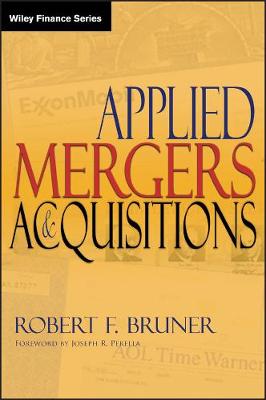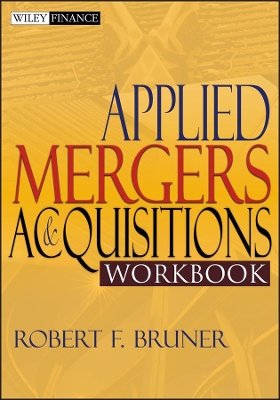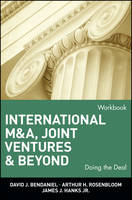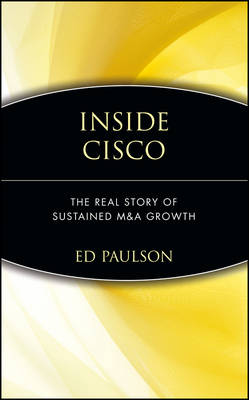Mergers
 -15%
portes grátis
-15%
portes grátis
Mergers
What Can Go Wrong and How to Prevent It
Gaughan, Patrick A.
John Wiley & Sons Inc
06/2005
356
Dura
Inglês
9780471419006
15 a 20 dias
724
Descrição não disponível.
Preface. Chapter 1: Introduction to Mergers and Acquisitions.
Background and Terminology.
Merger Process.
Economic Classifications of Mergers and Acquisitions.
Regulatory Framework of Mergers and Acquisitions.
Antitrust Laws.
State Corporation Laws.
Hostile Takeovers.
Takeover Defense.
Leveraged Transactions.
Restructurings.
Reasoning for Mergers and Acquisitions.
Trends in Mergers.
Conclusion.
Case Study: Lessons from the Failures of the Fourth Merger Wave.
Chapter 2: Merger Strategy: Why Do Firms Merge?
Growth.
Examples of Growth as an Inappropriate Goal.
Using M&As to Achieve Growth.
M&As in a Slow-Growth Industry as a Way to Achieve Growth.
Synergy.
Merger Gains: Operating Synergy or Revenue Enhancements-Case of Banking Industry.
Industry Clustering.
Deregulation.
Improved Management Hypothesis.
Hubris Hypothesis of Takeovers.
Winner's Curse and the Hubris Hypothesis.
Cross-Industry Deals and Hubris.
Diversification and CEO Compensation.
Diversification that Does Seem to Work Better: Related Diversification.
Merging to Achieve Greater Market Power.
Do Firms Really Merge to Achieve Market Power?
Merging to Achieve the Benefits of Vertical Integration.
Special Cases of Mergers Motivated by Specific Needs.
Conclusion.
Case Study: Vivendi.
Chapter 3: Merger Success Research.
Criteria for Defining Merger Success Using Research Studies.
Takeover Premiums and Control.
Initial Comment on Merger Research Studies.
Research Studies.
Mergers of Equals: Acquirers versus Target Gains.
Firm Size and Acquisition Gains.
Long-Term Research Studies.
Long- versus Short-Term Performance and Method of Payment.
Bidder Long-Term Effects: Methods of Payment.
Bidder's Performance Over the Fifth Merger Wave.
Conclusion.
Case Study: Montana Power-Moving into Unfamiliar Areas.
Chapter 4: Valuation and Overpaying.
Valuation: Part Science and Part Art.
Valuation: Buyer versus Seller's Perspective.
Synergy, Valuation, and the Discount Rate.
Financial Synergies and the Discount Rate.
Toe Holds and Bidding Contests.
Bidding Contest Protections.
Overpaying and Fraudulent Seller Financials.
Valuation and Hidden Costs.
Postmerger Integration Costs-Hard Costs to Measure.
Conclusion.
Case Study: AOL Time Warner.
Chapter 5: Corporate Governance: Part of the Solution.
Governance Failure.
Regulatory Changes.
Corporate Governance.
Managerial Compensation and Firm Size.
Managerial Compensation, Mergers, and Takeovers.
Disciplinary Takeovers, Company Performance, and CEOs and Boards.
Managerial and Director Voting Power and Takeovers.
Shareholder Wealth Effects of Mergers and Acquisitions and Corporation Acquisition Decisions.
Post-Acquisitions Performance and Executive Compensation.
Lessons from the Hewlett-Packard-Compaq Merger: Shareholders Lose, CEOs Gain.
CEO Power and Compensation.
Do Boards Reward CEOs for Initiating Acquisitions and Mergers?
Corporate Governance and Mergers of Equals.
Antitakeover Measures and Corporate Governance.
Conclusion.
Case Study: WorldCom.
Chapter 6: Reversing the Error: Sell-Offs and Other Restructurings.
Divestitures.
Decision: Retain or Sell Off.
Spin-Offs.
Involuntary Spin-Offs.
Defensive Spin-Offs.
Tax Benefits of Spin-Offs.
Shareholder Wealth Effects of Sell-Offs.
Rationale for a Positive Stock Price Reaction to Sell-Offs.
Wealth Effects of Voluntary Defensive Sell-Offs.
Wealth Effects of Involuntary Sell-Offs.
Financial Benefits for Buyers of Sold-Off Entities.
Shareholder Wealth Effects of Spin-Offs.
Corporate Focus and Spin-Offs.
Equity Carve-Outs.
Benefits of Equity Carve-Outs.
Equity Carve-Outs Are Different from Other Public Offerings.
Shareholder Wealth Effects of Equity Carve-Outs.
Under Which Situations Should a Company Do a Spin-Off versus an Equity Carve-Out?
Shareholder Wealth Effects of Tracking Stock Issuances.
Conclusion.
Case Study: DaimlerChrysler.
Chapter 7: Joint Ventures and Strategic Alliances: Alternatives to Mergers and Acquisitions.
Contractual Agreements.
Comparing Strategic Alliances and Joint Ventures with Mergers and Acquisitions.
Joint Ventures.
Motives for Joint Ventures.
Regulation and Joint Ventures.
Shareholder Wealth Effects of Joint Ventures.
Shareholder Wealth Effects by Type of Venture.
Restructuring and Joint Ventures.
Potential Problems with Joint Ventures.
Strategic Alliances.
Governance of Strategic Alliances.
Shareholder Wealth Effects of Strategic Alliances.
Shareholder Wealth Effects by Type of Alliance.
What Determines the Success of Strategic Alliances?
Potential for Conflicts with Joint Ventures and Strategic Alliances.
Cross Stock Holdings as Conflict Insurance.
Conclusion.
Case Study: AT&T.
Index.
Background and Terminology.
Merger Process.
Economic Classifications of Mergers and Acquisitions.
Regulatory Framework of Mergers and Acquisitions.
Antitrust Laws.
State Corporation Laws.
Hostile Takeovers.
Takeover Defense.
Leveraged Transactions.
Restructurings.
Reasoning for Mergers and Acquisitions.
Trends in Mergers.
Conclusion.
Case Study: Lessons from the Failures of the Fourth Merger Wave.
Chapter 2: Merger Strategy: Why Do Firms Merge?
Growth.
Examples of Growth as an Inappropriate Goal.
Using M&As to Achieve Growth.
M&As in a Slow-Growth Industry as a Way to Achieve Growth.
Synergy.
Merger Gains: Operating Synergy or Revenue Enhancements-Case of Banking Industry.
Industry Clustering.
Deregulation.
Improved Management Hypothesis.
Hubris Hypothesis of Takeovers.
Winner's Curse and the Hubris Hypothesis.
Cross-Industry Deals and Hubris.
Diversification and CEO Compensation.
Diversification that Does Seem to Work Better: Related Diversification.
Merging to Achieve Greater Market Power.
Do Firms Really Merge to Achieve Market Power?
Merging to Achieve the Benefits of Vertical Integration.
Special Cases of Mergers Motivated by Specific Needs.
Conclusion.
Case Study: Vivendi.
Chapter 3: Merger Success Research.
Criteria for Defining Merger Success Using Research Studies.
Takeover Premiums and Control.
Initial Comment on Merger Research Studies.
Research Studies.
Mergers of Equals: Acquirers versus Target Gains.
Firm Size and Acquisition Gains.
Long-Term Research Studies.
Long- versus Short-Term Performance and Method of Payment.
Bidder Long-Term Effects: Methods of Payment.
Bidder's Performance Over the Fifth Merger Wave.
Conclusion.
Case Study: Montana Power-Moving into Unfamiliar Areas.
Chapter 4: Valuation and Overpaying.
Valuation: Part Science and Part Art.
Valuation: Buyer versus Seller's Perspective.
Synergy, Valuation, and the Discount Rate.
Financial Synergies and the Discount Rate.
Toe Holds and Bidding Contests.
Bidding Contest Protections.
Overpaying and Fraudulent Seller Financials.
Valuation and Hidden Costs.
Postmerger Integration Costs-Hard Costs to Measure.
Conclusion.
Case Study: AOL Time Warner.
Chapter 5: Corporate Governance: Part of the Solution.
Governance Failure.
Regulatory Changes.
Corporate Governance.
Managerial Compensation and Firm Size.
Managerial Compensation, Mergers, and Takeovers.
Disciplinary Takeovers, Company Performance, and CEOs and Boards.
Managerial and Director Voting Power and Takeovers.
Shareholder Wealth Effects of Mergers and Acquisitions and Corporation Acquisition Decisions.
Post-Acquisitions Performance and Executive Compensation.
Lessons from the Hewlett-Packard-Compaq Merger: Shareholders Lose, CEOs Gain.
CEO Power and Compensation.
Do Boards Reward CEOs for Initiating Acquisitions and Mergers?
Corporate Governance and Mergers of Equals.
Antitakeover Measures and Corporate Governance.
Conclusion.
Case Study: WorldCom.
Chapter 6: Reversing the Error: Sell-Offs and Other Restructurings.
Divestitures.
Decision: Retain or Sell Off.
Spin-Offs.
Involuntary Spin-Offs.
Defensive Spin-Offs.
Tax Benefits of Spin-Offs.
Shareholder Wealth Effects of Sell-Offs.
Rationale for a Positive Stock Price Reaction to Sell-Offs.
Wealth Effects of Voluntary Defensive Sell-Offs.
Wealth Effects of Involuntary Sell-Offs.
Financial Benefits for Buyers of Sold-Off Entities.
Shareholder Wealth Effects of Spin-Offs.
Corporate Focus and Spin-Offs.
Equity Carve-Outs.
Benefits of Equity Carve-Outs.
Equity Carve-Outs Are Different from Other Public Offerings.
Shareholder Wealth Effects of Equity Carve-Outs.
Under Which Situations Should a Company Do a Spin-Off versus an Equity Carve-Out?
Shareholder Wealth Effects of Tracking Stock Issuances.
Conclusion.
Case Study: DaimlerChrysler.
Chapter 7: Joint Ventures and Strategic Alliances: Alternatives to Mergers and Acquisitions.
Contractual Agreements.
Comparing Strategic Alliances and Joint Ventures with Mergers and Acquisitions.
Joint Ventures.
Motives for Joint Ventures.
Regulation and Joint Ventures.
Shareholder Wealth Effects of Joint Ventures.
Shareholder Wealth Effects by Type of Venture.
Restructuring and Joint Ventures.
Potential Problems with Joint Ventures.
Strategic Alliances.
Governance of Strategic Alliances.
Shareholder Wealth Effects of Strategic Alliances.
Shareholder Wealth Effects by Type of Alliance.
What Determines the Success of Strategic Alliances?
Potential for Conflicts with Joint Ventures and Strategic Alliances.
Cross Stock Holdings as Conflict Insurance.
Conclusion.
Case Study: AT&T.
Index.
Este título pertence ao(s) assunto(s) indicados(s). Para ver outros títulos clique no assunto desejado.
megabilliondollar; highly; mergers; highprofile; experts; good; advisors; paper; hard; changes; wrong; authority patrick; researches; determining factors; gaughan; strategies; beyond; motives; financials; governance; trends; keeps; book
Preface. Chapter 1: Introduction to Mergers and Acquisitions.
Background and Terminology.
Merger Process.
Economic Classifications of Mergers and Acquisitions.
Regulatory Framework of Mergers and Acquisitions.
Antitrust Laws.
State Corporation Laws.
Hostile Takeovers.
Takeover Defense.
Leveraged Transactions.
Restructurings.
Reasoning for Mergers and Acquisitions.
Trends in Mergers.
Conclusion.
Case Study: Lessons from the Failures of the Fourth Merger Wave.
Chapter 2: Merger Strategy: Why Do Firms Merge?
Growth.
Examples of Growth as an Inappropriate Goal.
Using M&As to Achieve Growth.
M&As in a Slow-Growth Industry as a Way to Achieve Growth.
Synergy.
Merger Gains: Operating Synergy or Revenue Enhancements-Case of Banking Industry.
Industry Clustering.
Deregulation.
Improved Management Hypothesis.
Hubris Hypothesis of Takeovers.
Winner's Curse and the Hubris Hypothesis.
Cross-Industry Deals and Hubris.
Diversification and CEO Compensation.
Diversification that Does Seem to Work Better: Related Diversification.
Merging to Achieve Greater Market Power.
Do Firms Really Merge to Achieve Market Power?
Merging to Achieve the Benefits of Vertical Integration.
Special Cases of Mergers Motivated by Specific Needs.
Conclusion.
Case Study: Vivendi.
Chapter 3: Merger Success Research.
Criteria for Defining Merger Success Using Research Studies.
Takeover Premiums and Control.
Initial Comment on Merger Research Studies.
Research Studies.
Mergers of Equals: Acquirers versus Target Gains.
Firm Size and Acquisition Gains.
Long-Term Research Studies.
Long- versus Short-Term Performance and Method of Payment.
Bidder Long-Term Effects: Methods of Payment.
Bidder's Performance Over the Fifth Merger Wave.
Conclusion.
Case Study: Montana Power-Moving into Unfamiliar Areas.
Chapter 4: Valuation and Overpaying.
Valuation: Part Science and Part Art.
Valuation: Buyer versus Seller's Perspective.
Synergy, Valuation, and the Discount Rate.
Financial Synergies and the Discount Rate.
Toe Holds and Bidding Contests.
Bidding Contest Protections.
Overpaying and Fraudulent Seller Financials.
Valuation and Hidden Costs.
Postmerger Integration Costs-Hard Costs to Measure.
Conclusion.
Case Study: AOL Time Warner.
Chapter 5: Corporate Governance: Part of the Solution.
Governance Failure.
Regulatory Changes.
Corporate Governance.
Managerial Compensation and Firm Size.
Managerial Compensation, Mergers, and Takeovers.
Disciplinary Takeovers, Company Performance, and CEOs and Boards.
Managerial and Director Voting Power and Takeovers.
Shareholder Wealth Effects of Mergers and Acquisitions and Corporation Acquisition Decisions.
Post-Acquisitions Performance and Executive Compensation.
Lessons from the Hewlett-Packard-Compaq Merger: Shareholders Lose, CEOs Gain.
CEO Power and Compensation.
Do Boards Reward CEOs for Initiating Acquisitions and Mergers?
Corporate Governance and Mergers of Equals.
Antitakeover Measures and Corporate Governance.
Conclusion.
Case Study: WorldCom.
Chapter 6: Reversing the Error: Sell-Offs and Other Restructurings.
Divestitures.
Decision: Retain or Sell Off.
Spin-Offs.
Involuntary Spin-Offs.
Defensive Spin-Offs.
Tax Benefits of Spin-Offs.
Shareholder Wealth Effects of Sell-Offs.
Rationale for a Positive Stock Price Reaction to Sell-Offs.
Wealth Effects of Voluntary Defensive Sell-Offs.
Wealth Effects of Involuntary Sell-Offs.
Financial Benefits for Buyers of Sold-Off Entities.
Shareholder Wealth Effects of Spin-Offs.
Corporate Focus and Spin-Offs.
Equity Carve-Outs.
Benefits of Equity Carve-Outs.
Equity Carve-Outs Are Different from Other Public Offerings.
Shareholder Wealth Effects of Equity Carve-Outs.
Under Which Situations Should a Company Do a Spin-Off versus an Equity Carve-Out?
Shareholder Wealth Effects of Tracking Stock Issuances.
Conclusion.
Case Study: DaimlerChrysler.
Chapter 7: Joint Ventures and Strategic Alliances: Alternatives to Mergers and Acquisitions.
Contractual Agreements.
Comparing Strategic Alliances and Joint Ventures with Mergers and Acquisitions.
Joint Ventures.
Motives for Joint Ventures.
Regulation and Joint Ventures.
Shareholder Wealth Effects of Joint Ventures.
Shareholder Wealth Effects by Type of Venture.
Restructuring and Joint Ventures.
Potential Problems with Joint Ventures.
Strategic Alliances.
Governance of Strategic Alliances.
Shareholder Wealth Effects of Strategic Alliances.
Shareholder Wealth Effects by Type of Alliance.
What Determines the Success of Strategic Alliances?
Potential for Conflicts with Joint Ventures and Strategic Alliances.
Cross Stock Holdings as Conflict Insurance.
Conclusion.
Case Study: AT&T.
Index.
Background and Terminology.
Merger Process.
Economic Classifications of Mergers and Acquisitions.
Regulatory Framework of Mergers and Acquisitions.
Antitrust Laws.
State Corporation Laws.
Hostile Takeovers.
Takeover Defense.
Leveraged Transactions.
Restructurings.
Reasoning for Mergers and Acquisitions.
Trends in Mergers.
Conclusion.
Case Study: Lessons from the Failures of the Fourth Merger Wave.
Chapter 2: Merger Strategy: Why Do Firms Merge?
Growth.
Examples of Growth as an Inappropriate Goal.
Using M&As to Achieve Growth.
M&As in a Slow-Growth Industry as a Way to Achieve Growth.
Synergy.
Merger Gains: Operating Synergy or Revenue Enhancements-Case of Banking Industry.
Industry Clustering.
Deregulation.
Improved Management Hypothesis.
Hubris Hypothesis of Takeovers.
Winner's Curse and the Hubris Hypothesis.
Cross-Industry Deals and Hubris.
Diversification and CEO Compensation.
Diversification that Does Seem to Work Better: Related Diversification.
Merging to Achieve Greater Market Power.
Do Firms Really Merge to Achieve Market Power?
Merging to Achieve the Benefits of Vertical Integration.
Special Cases of Mergers Motivated by Specific Needs.
Conclusion.
Case Study: Vivendi.
Chapter 3: Merger Success Research.
Criteria for Defining Merger Success Using Research Studies.
Takeover Premiums and Control.
Initial Comment on Merger Research Studies.
Research Studies.
Mergers of Equals: Acquirers versus Target Gains.
Firm Size and Acquisition Gains.
Long-Term Research Studies.
Long- versus Short-Term Performance and Method of Payment.
Bidder Long-Term Effects: Methods of Payment.
Bidder's Performance Over the Fifth Merger Wave.
Conclusion.
Case Study: Montana Power-Moving into Unfamiliar Areas.
Chapter 4: Valuation and Overpaying.
Valuation: Part Science and Part Art.
Valuation: Buyer versus Seller's Perspective.
Synergy, Valuation, and the Discount Rate.
Financial Synergies and the Discount Rate.
Toe Holds and Bidding Contests.
Bidding Contest Protections.
Overpaying and Fraudulent Seller Financials.
Valuation and Hidden Costs.
Postmerger Integration Costs-Hard Costs to Measure.
Conclusion.
Case Study: AOL Time Warner.
Chapter 5: Corporate Governance: Part of the Solution.
Governance Failure.
Regulatory Changes.
Corporate Governance.
Managerial Compensation and Firm Size.
Managerial Compensation, Mergers, and Takeovers.
Disciplinary Takeovers, Company Performance, and CEOs and Boards.
Managerial and Director Voting Power and Takeovers.
Shareholder Wealth Effects of Mergers and Acquisitions and Corporation Acquisition Decisions.
Post-Acquisitions Performance and Executive Compensation.
Lessons from the Hewlett-Packard-Compaq Merger: Shareholders Lose, CEOs Gain.
CEO Power and Compensation.
Do Boards Reward CEOs for Initiating Acquisitions and Mergers?
Corporate Governance and Mergers of Equals.
Antitakeover Measures and Corporate Governance.
Conclusion.
Case Study: WorldCom.
Chapter 6: Reversing the Error: Sell-Offs and Other Restructurings.
Divestitures.
Decision: Retain or Sell Off.
Spin-Offs.
Involuntary Spin-Offs.
Defensive Spin-Offs.
Tax Benefits of Spin-Offs.
Shareholder Wealth Effects of Sell-Offs.
Rationale for a Positive Stock Price Reaction to Sell-Offs.
Wealth Effects of Voluntary Defensive Sell-Offs.
Wealth Effects of Involuntary Sell-Offs.
Financial Benefits for Buyers of Sold-Off Entities.
Shareholder Wealth Effects of Spin-Offs.
Corporate Focus and Spin-Offs.
Equity Carve-Outs.
Benefits of Equity Carve-Outs.
Equity Carve-Outs Are Different from Other Public Offerings.
Shareholder Wealth Effects of Equity Carve-Outs.
Under Which Situations Should a Company Do a Spin-Off versus an Equity Carve-Out?
Shareholder Wealth Effects of Tracking Stock Issuances.
Conclusion.
Case Study: DaimlerChrysler.
Chapter 7: Joint Ventures and Strategic Alliances: Alternatives to Mergers and Acquisitions.
Contractual Agreements.
Comparing Strategic Alliances and Joint Ventures with Mergers and Acquisitions.
Joint Ventures.
Motives for Joint Ventures.
Regulation and Joint Ventures.
Shareholder Wealth Effects of Joint Ventures.
Shareholder Wealth Effects by Type of Venture.
Restructuring and Joint Ventures.
Potential Problems with Joint Ventures.
Strategic Alliances.
Governance of Strategic Alliances.
Shareholder Wealth Effects of Strategic Alliances.
Shareholder Wealth Effects by Type of Alliance.
What Determines the Success of Strategic Alliances?
Potential for Conflicts with Joint Ventures and Strategic Alliances.
Cross Stock Holdings as Conflict Insurance.
Conclusion.
Case Study: AT&T.
Index.
Este título pertence ao(s) assunto(s) indicados(s). Para ver outros títulos clique no assunto desejado.











